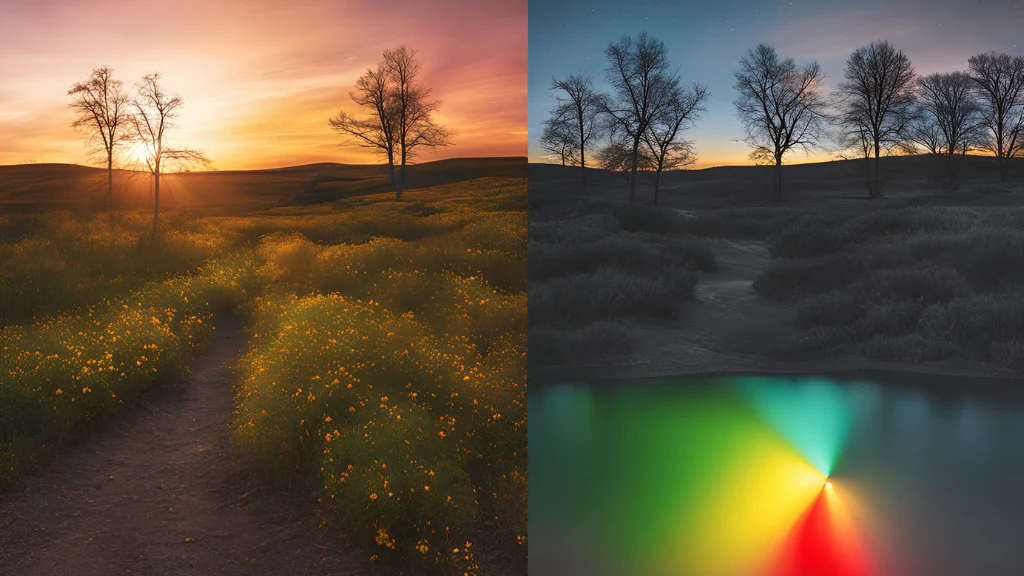If you’re into outdoor adventures, you probably already know a thing or two about picking the right flashlight.
You’ve likely got your checklist:Flashlights need to be bright, lightweight, have a long battery life, and sturdy enough to withstand some collisions and splashes. Besides, who doesn’t like a flashlight with multiple brightness modes and convenient USB charging?
These are basic requirements, let’s talk about some lesser known but impactful features, such as CRI and color temperature. These may sound fancy, but they are very important when you are in the wild.
What’s the deal with CRI?
CRI, or Color Rendering Index, is all about how well a light shows colors.
Think of it like this: The CRI of the sun is 100, which means it can display colors unchanged. The scores of other light sources are lower, depending on their distance from the sun. High CRI means you can see colors more accurately, which can be very important when trying to discover things in nature outdoors.
Of course, brightness is the key to seeing the big picture clearly, but when you want to pay attention to details – such as determining whether a berry is red or green – good CRI is the key. A flashlight with a CRI of 75 may need to be brighter to display the same details as a flashlight with a CRI of 90+.
Picture this:You shine a flashlight on some strawberries. Under high CRI light (such as CRI 95), these strawberries look juicy and bright. But under lower CRI light (such as CRI 75), they may appear a bit dull and lifeless. Not that delicious, right.

Why High CRI Matters
So, why should we care about CRI? Firstly, it can help you see things more clearly, which is very important outdoors.
Imagine mistaking a venomous snake for a harmless stick due to your lighting not displaying colors correctly – this is not the situation you want. High CRI lights allow you to observe things around you more clearly and accurately, which is crucial for ensuring your safety.
If you enjoy taking adventure photos, high CRI lights are essential. It makes the colors more vibrant, allowing you to capture natural scenery worth seeing on Instagram. That’s why companies like Wuben ensure that some of their flashlights have high CRI options – because who wouldn’t want to have the best of both worlds?
What About Color Temperature?
When we talk about color temperature, we’re talking about how “warm” or “cool” the light looks. Flashlights usually come in three flavors:
- cool white (around 6500K)
- neutral white (around 4000K)
- warm white (less than 3000K)
LED flashlights emit light by exciting blue LED chips with some fluorescent powder, which then produces yellow light. The mixture of blue and yellow produces white light. Yellow light has a higher color rendering index, while blue has only one wavelength. Therefore, in order to achieve better color rendering, you need to turn up the yellow color.
Generally speaking, warm light (with lower color temperature) has a higher color rendering index, making it very suitable for activities that require seeing real colors. In addition, warm light has a longer wavelength, which means it can better penetrate fog and help you see more clearly in bad weather. What are the drawbacks? Warm colored LEDs sometimes appear a bit dim, making everything appear pale yellow, just like old-fashioned light bulbs.

Neutral white is a choice for “blonde girls” – neither too cold nor too warm. It strikes a good balance between accurately displaying colors and being bright enough, which is why it has become the preferred choice for outdoor activities. You will see many flashlights, including Wuben’s flashlights, using this color temperature.
The Lowdown on Colored Lights
Flashlights with colored lights (red, green, blue, and even ultraviolet) are not just for display. They each have their own special purposes:
Red light: Red light is harmless to the eyes, which means it helps protect your night vision ability. It is very suitable for activities such as stargazing or reading maps, without dazzling you or your companions. It is also useful in foggy or humid environments because it can penetrate haze better than white light.
Blue light: Blue light has some cool techniques. It is very suitable for tracking bloodstains or discovering oil stains on machines during hunting. It is also popular for fishing at night because it does not startle the fish and can make certain things glow, such as fishing floats or certain types of bait.
Green light: Green light is very easy for our eyes to recognize, so even without dimming, it looks brighter. This makes it an ideal choice for reading maps or doing anything that requires attention to detail.
Ultraviolet lamp: Ultraviolet lamps have some special uses, such as detecting scorpions (yes, they glow under ultraviolet light) or checking counterfeit currency. It’s not a daily necessity, but if you enjoy exploring strange and wonderful things, having it is cool.
If you enjoy photography, these colored lights can add some bright colors to your photos, especially when you’re playing with light painting.
Not all flashlights are created equal. Whether you are hiking, capturing outdoor scenery, or just looking ahead, understanding the ins and outs of CRI, color temperature, and colored lighting will be different.
So, next time you purchase a novice flashlight, don’t just choose the brightest one, think about what you need. A little knowledge can illuminate your path in multiple ways. Wishing you a pleasant adventure!



